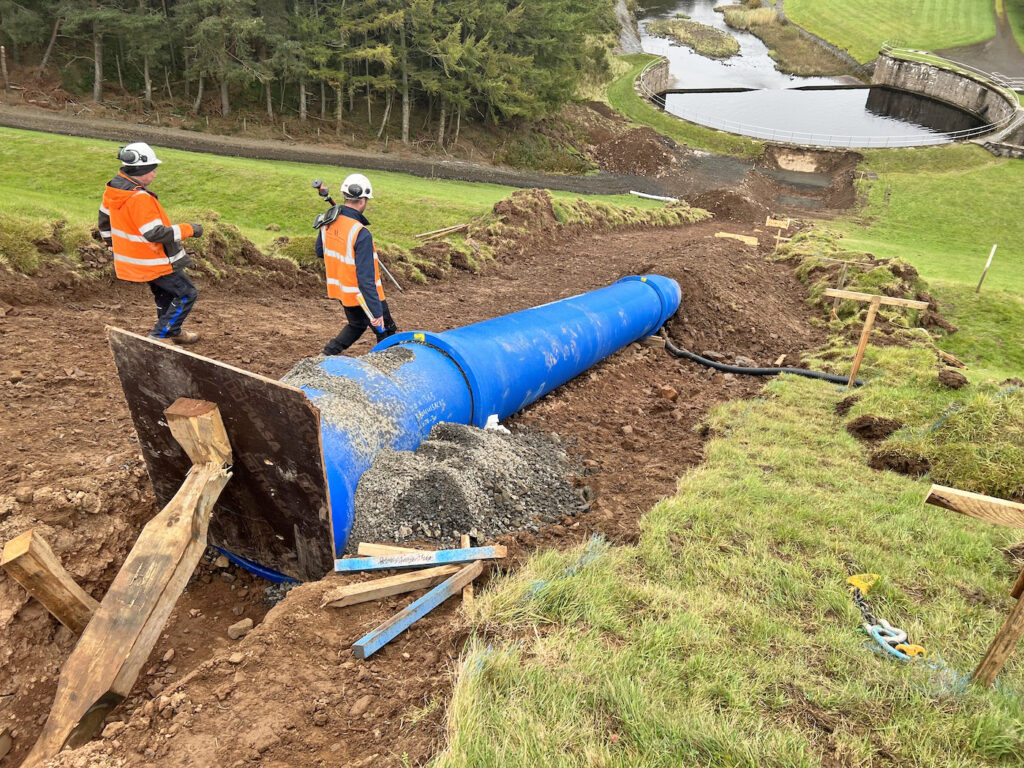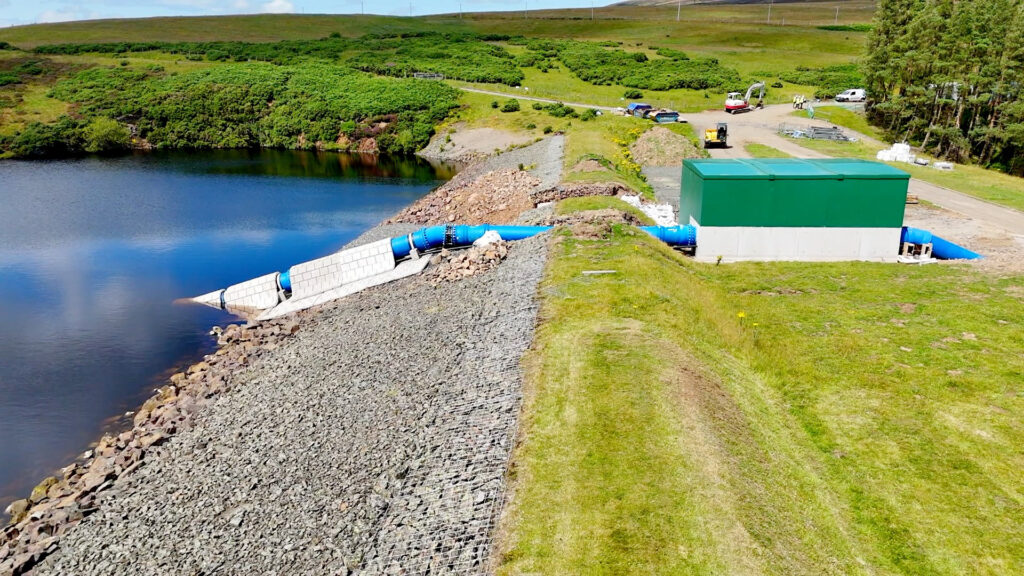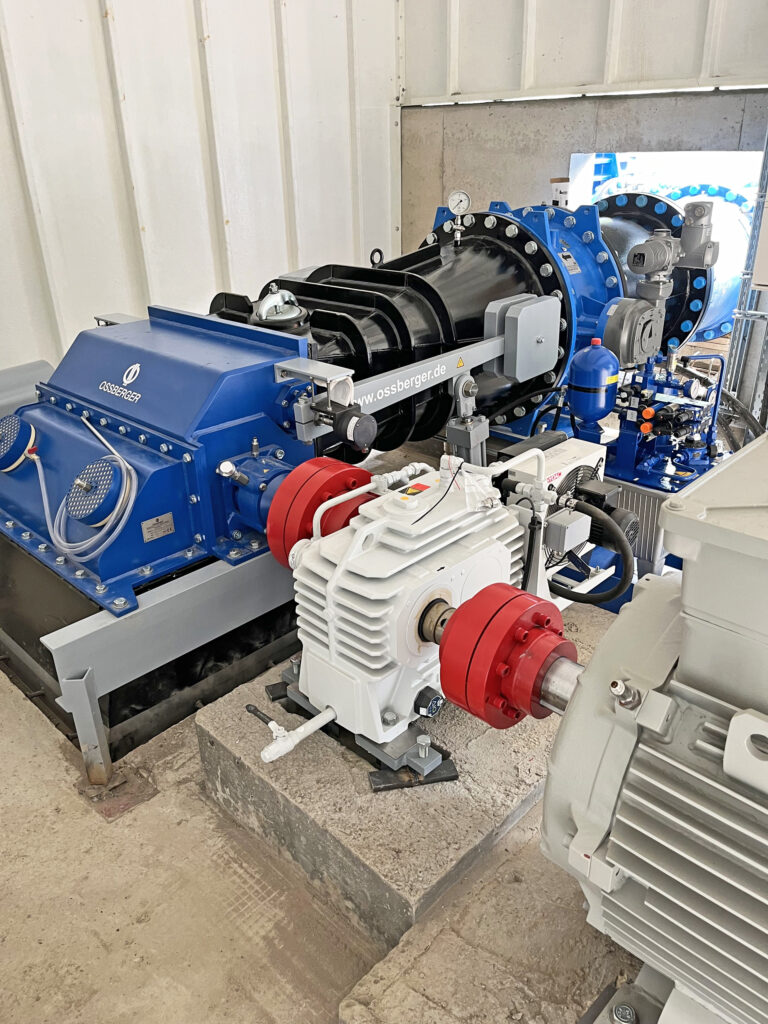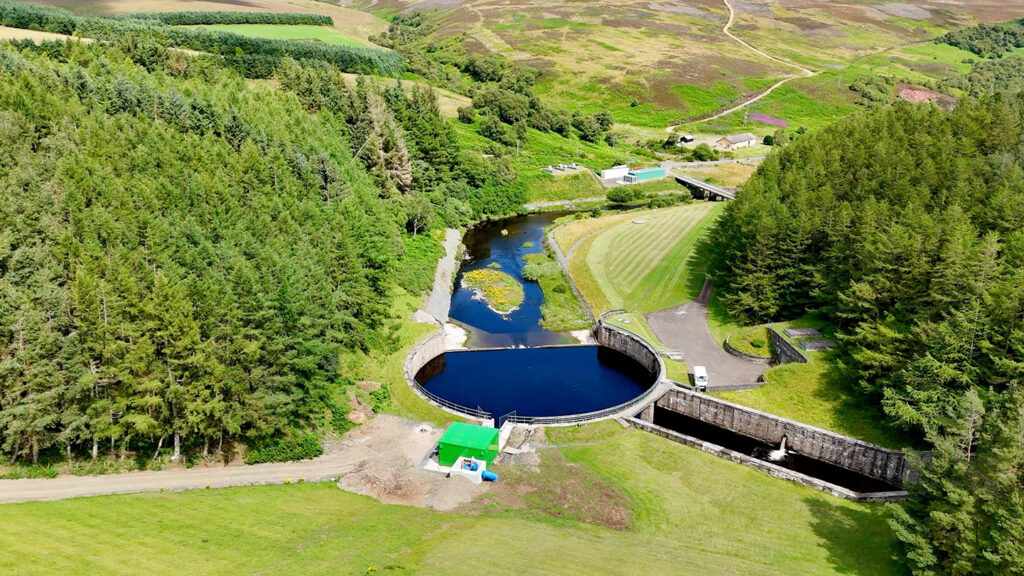Ossberger turbine produces green electricity at Whiteadder Reservoir in Scotland
An exemplary hydropower project was completed at Whiteadder drinking water reservoir in Scotland shortly before the end of the year. Installation of siphon technology has now enabled excess water from the reservoir to be drawn over the top of the dam and be used to generate electricity. Scottish Water, the power plant operator, believes this concept is the first of its kind in Europe. The electricity generated in the new small-scale hydropower plant is used directly on site for the local Hungry Snout pumping station – one of the largest of its type in the East Lothian region. Ossberger, German hydropower specialist, supplied all of the electromechanical and I&C equipment for the new small-scale power station. The powerful crossflow turbine is designed for a maximum capacity of almost 200kW, and now enables Scottish Water to offset around a third of the pumping station’s annual energy requirements with locally generated green electricity.

© Scotish Water
The construction of the new hydroelectric power plant at Whiteadder Reservoir was necessitated, basically, by the enormous rise in electricity costs – a development to which the United Kingdom has also not been immune in recent years. From an environmental perspective, the project also boosts the efforts of Scotland’s largest drinking and wastewater mover, Scottish Water, to tap the potential of the unused renewable energy in its extensive hydro-infrastructure portfolio. Scottish Water Horizons, a subsidiary of Scottish Water, identified this expansion potential by conducting a study analysing hundreds of sites across the country – including sewage treatment plants and reservoirs, and thousands of kilometres of drinking water and wastewater infrastructures.

© Scotish Water
Hungry Snout feeds on hydroelectric power
The study revealed Whiteadder Reservoir in the region of East Lothian to be one of the most suitable sites for the construction of a new small hydropower plant. The reservoir was originally constructed between 1964 and 1968 as an earth-filled dam to expand the region’s drinking water storage capacity. Actual drinking water treatment takes place at Castle Moffat Water Treatment Works, where the water is pumped through Hungry Snout, one of the most powerful pumping stations in East Lothian. The plant transports an average of 32 million litres of water from Whiteadder Reservoir to consumers around the region, and all the way up to Scotland’s capital city – Edinburgh. Construction of the new small-scale hydropower plant has meant that now almost a third of the pumping station’s energy requirements can be covered by locally generated green electricity.

© Scotish Water
Siphon system and hydropower plant combination
According to Scottish Water Horizons, the operating principle of the new hydropower plant in East Lothian is unique throughout Europe. Water is siphoned up a channel from the reservoir via pump-and-siphon technology, then fed into the new turbine building for electricity generation purposes. The siphon system is equipped with a vacuum pump that implements suction-induced water flow. Hydrostatic pressure guarantees an automatic supply of water from the reservoir. There are obvious advantages to this system – from structural, economic and ecological standpoints. The design chosen avoids the expense of conversion work on the dam structure – making overall implementation cheaper. Similarly, this solution left a low CO2 footprint during construction, and the hydropower project has also contributed to flood safety at the plant. Heavy rainfall can trigger flooding, so in such an event the penstock can be used for the targeted removal of water from the dam. In emergency discharge mode the extracted water bypasses the turbine through a pipe. Another benefit of the hydropower project has been an improvement in grid stability. The energy delivered to the pumping station by the small hydropower plant has boosted and stabilised energy availability from the local power grid significantly.
A powerful and robust turbine
The entire electromechanical and I&C equipment for the new small hydropower plant was supplied by the German hydropower specialists at Ossberger, from whom the original Whiteadder Reservoir plant concept also originated. “The project was finalised by Scottish Water Horizon, and various hydro-industry companies were commissioned to carry out planning and construction work. Ossberger supplied the centrepiece of the plant – a crossflow turbine – whose robust technology has proven its worth over 10,000 times worldwide,” explains Julian Jones, Ossberger’s representative for Scotland. The design of the turbine was kept simple very consciously, having only three moving parts, while providing power reliably and coping excellently with fluctuating inflows. This was facilitated by installing two cells inside the turbine to operate independently of each other. The smaller cell only needs 5 per cent of the expansion water volume to generate electricity via the turbine. For the new power plant at Whiteadder Reservoir, Ossberger supplied a turbine designed for a discharge rate of 1.2 m³/s and a net head of 25 metres that achieves a maximum output of 199kW at full load. Finally, the electrical infrastructure and control equipment completed the scope of delivery to ensure fully automatic plant operation.

© Scotish Water
Green power role model
Julian Jones cited compliance with the strict safety criteria, statutorily required for all structural changes in the dam area, as the biggest challenge faced during the approximately two-year phase of implementation. Special precautions had to be taken at several sites around the project area to ensure personal safety and structural integrity – as was the case for diving work and construction activity on the embankment. The new small-scale hydropower plant at Whiteadder Reservoir began producing electricity in December 2024, roughly two years after construction originally commenced. “The complexity of integrating a siphon system combination meant we were still busy with various fine-tuning tasks a long time after initial commissioning. Just a few months after completion, in automatic mode the power plant is producing a regular yearly average of 820,000 kWh energy reliably and efficiently,” says Julian Jones. Scottish Water is very pleased with the final result of this exemplary reference project in East Lothian and sees it as a further step towards achievement of the company’s environmental goals.